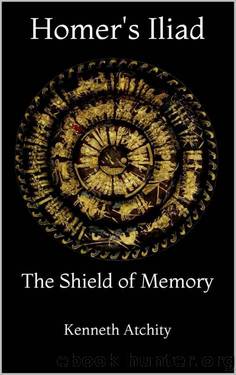Homer's Iliad: The Shield of Memory by Kenneth Atchity

Author:Kenneth Atchity [Atchity, Kenneth]
Language: eng
Format: epub
Publisher: Story Merchant
Published: 2014-06-28T04:00:00+00:00
The Informing Image
Homer's incredible elaboration of the shield of Achilles (Book 18) makes it the most singular, central image of the Iliad. An outline of the pictorial elements of the shield will help us appreciate its extraordinary distinction from other artifact images in the Iliad.
The shield's comprehensive subject material immediately impresses us. In this it is like and unlike the epic itself. For the overt subject of the Iliad is war and contention; its realistic quality, therefore, derives from the balance provided by the poet's frequent use of similes which complement the warlike action with visions of peace. Similarly, on the shield the actions of peace complement those of war. As does no other artifact, it reflects the all-encompassing scope of Homer's poetic perspective.
Hephaistos depicts the entirety of human experience partly by contrast. As Charles R. Beye comments, "most of the basic antitheses in the human situation: permanent and fleeting, beautiful and ugly, serene and excited, ideal and real, war and peace, finite world and infinite heaven" are included, in one way or another, upon its surface (p. 143). William Watkiss Lloyd is more specific:
The formula that is introductory to the city at war and city of peace, comprises them in fact, as relatively complementary; and the parallel treatment of each in three scenes gives emphasis to the intention . . . the ambuscade of the warriors by the riverside is opposed to a lively altercation in the marketplaceâa war-like incident of silence, stealth, and treachery, to a loud, clamourous, vehement incident of peace. On one side we see, in the careless piping swains approaching the fatal covert, the deceitful semblance of peace in war; and, on the other, the origin of a dispute in a manslaughter, as well as the violence of the dispute itself, betrays the seeds of contest and strife in the heart of peace. (Pp. 23, 31)
Through the juxtaposition of peaceful and warlike, political and pastoral pictures, the human world is framed. The shield is a vision of all that happens in Homer's cosmos. Though the center of vision of Hephaistos' handiwork is human life, the mundane activities of man are surrounded and put into perspective by the peripheral Ocean and the fixed stars at the center. The national diversity of mankind that Homer portrays in the antagonism between Argos and Troy is the reason why Hephaistos has created two cities on his shield. On a tool of warfare, all human scenesâfrom every level of the hierarchy of relations, in every possible degree of social stabilityâare shown. And every art known to Homeric man is also represented.
The single simile on the shield is one which likens the dance to the potter at his wheel. Art is represented on Hephaistos' artifact in both a linear and a circular mode. Each of the several scenes includes artistry, in one form or another, as an integral part of a social activityâfor example, the marriage songs in the city at peace. But the dance with which the smith concludes his
Download
This site does not store any files on its server. We only index and link to content provided by other sites. Please contact the content providers to delete copyright contents if any and email us, we'll remove relevant links or contents immediately.
Harry Potter and the Prisoner of Azkaban by J K Rowling(3516)
The Sentinel (Jack Reacher) by Lee Child & Andrew Child(3292)
Harry Potter and the Prisoner of Azkaban by Rowling J K(3076)
The Tales of Beedle the Bard by J.k.rowling (eng)(2700)
Dungeon Crawler Carl by Matt Dinniman(2140)
The Gate of the Feral Gods: Dungeon Crawler Carl Book 4 by Matt Dinniman(1977)
Marauder (The Oregon Files) by Clive Cussler & Boyd Morrison(1924)
Better Off Dead by Lee Child & Andrew Child(1897)
The Other Emily by Dean Koontz(1660)
Migrations by Charlotte McConaghy(1621)
The Girl and the Mountain by Mark Lawrence(1613)
Gild (The Plated Prisoner Series Book 1) by Raven Kennedy(1610)
Mark Z. Danielewski's House of Leaves by Mark Z. Danielewski & Johnny Truant(1518)
A Desolation Called Peace by Arkady Martine(1505)
Ruthless Empire (Royal Elite Book 6) by Rina Kent(1490)
Near the Bone by Christina Henry(1471)
The OP MC: God of Winning by Logan Jacobs(1432)
Fable: A Novel by Adrienne Young(1429)
The Captive by Fiona King Foster(1394)
